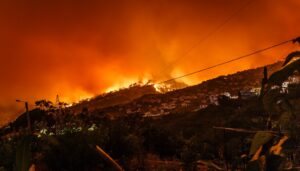Wildfires more likely due to climate crisis, but humans can reduce risk
Wildfires are increasing across the globe due to the climate crisis, according to new research which highlights how humans can reduce their impact.
Scientists from the University of East Anglia (UEA), along with partners including Swansea University and the University of Exeter, have revealed how global heating has led to hot, dry conditions, enhancing the risk of wildfires.
Regions which don’t usually experience wildfires are now susceptible, such as the Mediterranean and Amazonia, with all world regions likely to see fire weather if global temperatures reach 2-3°C higher.
This includes boreal forests in Siberia, Canada and Alaska, as each added degree of warming is thought to increase the risk of wildfires even further.

Lead author Dr Matthew Jones, of the Tyndall Centre for Climate Change Research at UEA, said: ‘Wildfires can have massive detrimental impacts on society, the economy, human health and livelihoods, biodiversity and carbon storage. These impacts are generally magnified in the case of forest wildfires.
‘Clarifying the link between forest wildfire trends and climate change is critical to understanding wildfire threats in future climates. Societies can either push with or pull against the rising risks of fire under climate change and regional actions and policies can certainly be important for preventing wildfires or reducing their severity.
‘Ultimately, though, we will be fighting the tide of escalating fire risks as the world warms further. Doubling down on efforts to cut greenhouse gas emissions and limiting warming to below 2°C is the most effective thing we can do to avoid the worst risks of wildfire on the global scale.’
The study explored past, present and future fire trends and modelled the impacts of human activity, land use and changing vegetation productivity.
Researchers highlighted the impact humans can have on wildfire activity, by increasing fire ignitions and reducing the natural resilience of ecosystems to fire through deforestation.
However, people have also reduced the spread of wildfires, by converting fire-prone landscapes to agriculture and are able to supress fires through firefighting.
But the authors warned that fire is a natural component of some functioning ecosystems, with policies excluding fire from western US landscape during the 20th century now resulting in an excess of vegetation fuels.
Low-intensity fires controlled during safe weather conditions can be valuable in keeping naturally occurring fuels low and allowing natural ecosystem functions.
Co-author Dr Cristina Santín, from Swansea University and the Spanish National Research Council, added: ‘Despite the fact that weather conditions promoting wildfire have already increased in nearly in every region the globe and will continue to do so, human factors still mediate or override the climatic ones in many regions.
‘We hope this research helps to resolve the entrenched and conflicting views on climate change versus land management being the root cause of these catastrophic fires.’
Photo by Michael Held












